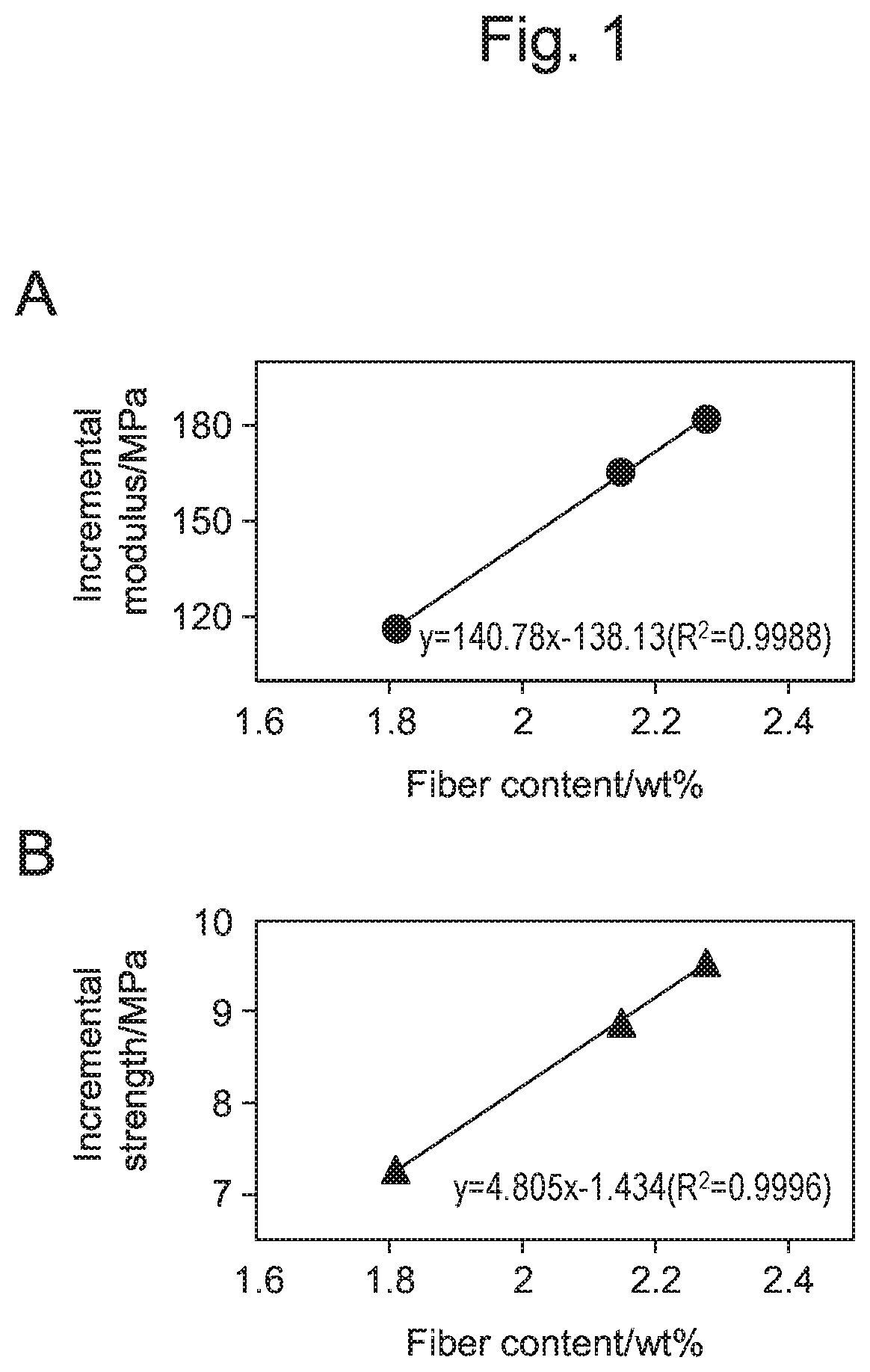Fiber-reinforced composite material and method for manufacturing same
a fiber-reinforced composite material and fiber-reinforced technology, applied in the field can solve the problems of “brittleness” of fiber-reinforced composite materials, peeling of reinforcing fibers, and many practical problems to be solved, and achieve high elastic modulus and high strength
- Summary
- Abstract
- Description
- Claims
- Application Information
AI Technical Summary
Benefits of technology
Problems solved by technology
Method used
Image
Examples
example 1
n of Fiber-Reinforced Composite Material Containing Bagworm Silk Thread as Reinforcing Fiber (1)
(Purpose)
[0077]A fiber-reinforced composite material containing the bagworm silk thread as reinforcing fiber is prepared, and the physical properties thereof are verified.
(Method)
[0078]Long-fiber bundle of the bagworm silk thread was used as reinforcing fiber, and an ethylene-vinyl acetate copolymer (EVA) resin was used as a polymer matrix.
[0079]Long-fiber bundles of the bagworm silk thread was prepared according to the method described in the specification of Japanese Patent Application No. 2017-110003. The bagworms used herein were the last instars of Eumeta japonica collected at an orchard in Tsukuba, Ibaraki, Japan. An approximately square metal is described in Example 1 of the specification of Japanese Patent Application No. 2017-110003 was used as a production apparatus of the long fiber of the bagworm silk thread. In the metal can, a closed ring-like rail with its floor directed up...
example 2
n of Fiber-Reinforced Composite Material Containing Bagworm Silk Thread as Reinforcing Fiber (2)
(Purpose)
[0087]A fiber-reinforced composite material is prepared using bagworm silk threads as reinforcing fiber and a polymer matrix differing from that of Example 1, and then the physical properties thereof are verified.
(Method)
[0088]The EVA resin used in Example 1 was a soft resin that can be extended several folds. In this example, a fiber-reinforced composite material (BSF / PS composite material) using a polystyrene resin (PS resin) (Eiken Chemical Co., Ltd.), which was a hard resin having elongation lower than that of the EVA resin and having a breaking elongation of about only 5%, as a polymer matrix was prepared, and then the mechanical properties thereof were verified in the same manner as in Example 1.
[0089]Basic conditions were according to the method of Example 1, except that the pressing condition was 10 MPa to 12 MPa at 150° C.
(Results)
[0090]The results of the mechanical test...
example 3
n of Fiber-Reinforced Composite Material Containing Short-Filament Bagworm Silk Thread as Reinforcing Fiber
(Purpose)
[0092]The physical properties of a fiber-reinforced composite material containing short filament bagworm silk thread as reinforcing fibers are verified.
(Method)
[0093]Short-fiber bagworm silk thread was used as reinforcing fiber and polyvinyl alcohol (PVA) (Uehara Chemical Co., Ltd. (Kabushikigaisha Uehara Kagaku)) was used as a polymer matrix.
[0094]A single fiber of the bagworm silk thread was cut in such a manner that the longer axis had a length of about 5 mm, thereby preparing short fiber. Subsequently, short fibers were dispersed in an aqueous PVA solution, and then shaped on slide glass, thereby obtaining a film as a BSF / PVA composite material. The fiber content was represented by the mass percentage of the short-fiber bagworm silk thread relative to the total dry mass of the film. Strip-shaped test piece was cut out from the film, and then subjected to the follow...
PUM
| Property | Measurement | Unit |
|---|---|---|
| Percent by mass | aaaaa | aaaaa |
| Percent by mass | aaaaa | aaaaa |
| Mass | aaaaa | aaaaa |
Abstract
Description
Claims
Application Information
 Login to View More
Login to View More - R&D
- Intellectual Property
- Life Sciences
- Materials
- Tech Scout
- Unparalleled Data Quality
- Higher Quality Content
- 60% Fewer Hallucinations
Browse by: Latest US Patents, China's latest patents, Technical Efficacy Thesaurus, Application Domain, Technology Topic, Popular Technical Reports.
© 2025 PatSnap. All rights reserved.Legal|Privacy policy|Modern Slavery Act Transparency Statement|Sitemap|About US| Contact US: help@patsnap.com


